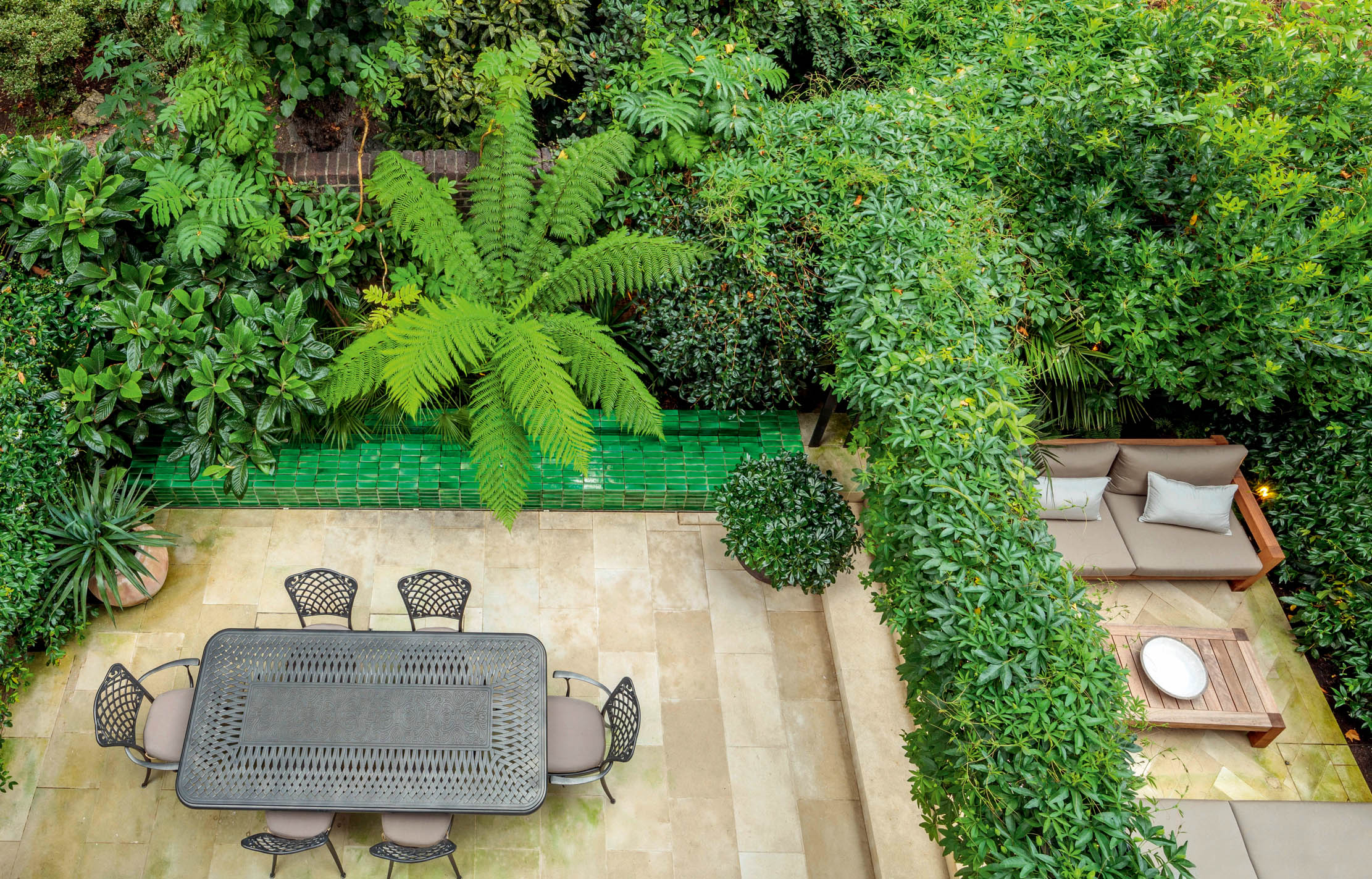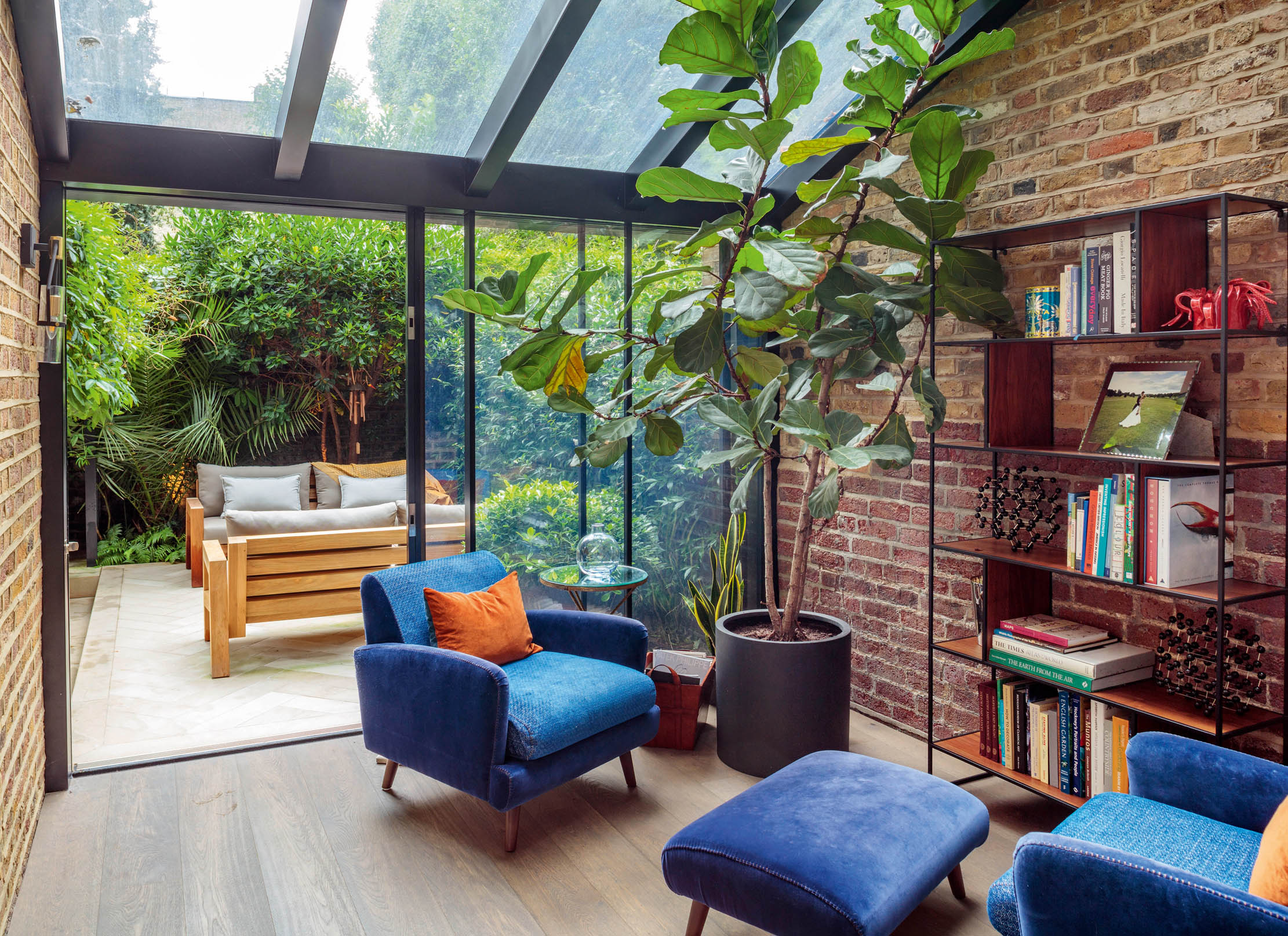City garden tips: 10 ways to bring a touch of English country garden to your outside space in the metropolis
This typically-dark city back garden in Kensington has been transformed with a tapestry of foliage. Tiffany Daneff takes a look at how it was done, and discovers the ten rules that we can draw from this beautiful creation in the heart of W8.


This garden began with a roll of wallpaper, Fern by Cole & Son, to be precise. A rather lovely paper of mostly greens and turquoise, it features a jungly scene of tree ferns and Muehlenbeckia (the string-of-pearls plant). This had been used to paper the boot room, which now looks over a lush, green back garden in Kensington.
Three years ago, when the 1841 Regency-style terraced house was being refurbished, this 510sq ft area was buried under heaps of builders’ material.
1. Borrow the landscape
Emphasise views to attractive features beyond the boundary
2. Position trees carefully
They’ll look good and hide eyesores
3. Keep the edges at the same height
Bring all boundary walls to the same height, using trellis if necessary
4. Bring the inside outside
Use similar materials inside and out to extend the space
5. Go to the edges
Build features all the way to the boundary wall to maximise the sense of space
Exquisite houses, the beauty of Nature, and how to get the most from your life, straight to your inbox.
6. Planters are perfect
Add to the plant material by using large statement planters that take their cue from the architecture of the interior
7. Grow upwards and sideways
Consider the third dimension—walls, trellis, pergola—and train climbers on them
8. Provide generous planting beds
Hide them underneath the hard landscaping if necessary
9. Get the lighting right
In this London garden, lights are powered by an armoured cable buried against the back wall. Uplighters are not pointing straight, but always achieved through crossing lights, which create dark and light shadow.
10. Use every chance
Finally the golden rule: remember that in a small garden, every plant counts.

At first sight, the small, rectangular garden, like so many in London, didn’t appear prepossessing, being north facing, dark and with high brick walls on all sides. But there were handsome holm oaks in a neighbouring garden, three Irish yews in another and next door had planted some fresh green feathery bamboo as a screen, which fitted in perfectly with the plans for a garden filled with greenery. Overhead, the branches of London planes gave a soft dappled light.
‘The client,’ recalls Alasdair Cameron of Cameron Gardens, ‘wanted lots of foliage of different kinds. They also wanted water.’ As the family had three young children, Mr Cameron came up with the idea of a tiled rill, powered by an internal ballcock-and-pump system that constantly pushes through water, along which little balsa-wood boats are often floated. This channel forms the beating heart of the garden, especially at night, when the green encaustic tiles are lit by a light at one end of the rill that shines through the water.
During the day, the gleaming tiles — which cleverly echo both the tiles that line the tunnels of the London underground, as well as hint at a Moroccan exoticism — brilliantly set up the drama of the many different leaf shapes. The tree fern’s feathered fronds are echoed with native ferns (Dryopteris affinis, Blechnum spicant and Polystichum setiferum), the Canary Island date palm, Phoenix canariensis, and the European fan palm, Chamaerops humilis. To contrast with these are the dark, glossy leaves of a multi-stemmed camellia, Osmanthus aquifolium, a scented sweet box, Sarcococca confusa, and a strawberry tree, Arbutus unedo, sited to hide an unattractive building beyond the boundary.

In a small garden, every plant has to play its part. A large Pittosporum tobira ‘Nanum’ dome, nicely set up in a generous dark planter, repeats the smooth, rounded leaf forms, as the almost black pot takes its cue from black beams that support the glass-roof in the lobby that leads off the kitchen into the garden.
The cross-referencing can be seen in the way that the rust-coloured bark of the tree fern is repeated in the orangey trunk of the arbutus and then reflected in terracotta pots. The success of the garden lies in its rich tapestry of foliage, which, in turn, is supported by deep planting beds that are cut under the hard landscaping, providing plenty of root space for the climbers, perennials and bulbs.
Although it faces north, the garden is quite protected. It gets a ‘drop of sun’ in the mornings and evenings and is lovely and cool in the summer — but it is dark. ‘To offset that, we chose paving that is light, but not white, as that goes black.’ English limestone was used for the herringbone terrace outside the lobby, mimicking the parquet floor upstairs, and chunky steps, (echoing the split-levels from the kitchen down to the lobby), drop to the main garden area. The steps are taken all the way back to the brick wall and connect with the boundary, ‘stretching the space to make it seem bigger’ — and the pergola sits on that.

The simple, black, powder-coated steel pergola is nice and light and supports a twining passiflora, which hangs in a delicate bright green drapery of tendrils that look good all year round. Originally, there were three different wall heights at the boundaries, but these have all been brought to the same height with black-cedar trellis. ‘All London gardens should have the same boundary lines,’ says Mr Cameron. ‘It creates clarity, as well as privacy. I think of them like the walls of a room.’
Climbers decorate much of the brick and are quickly covering the trellis, too. They include Clematis armandii ‘Appleblossom’ (early- to mid-spring fragrant flowers), Stauntonia hexaphylla (scented spring blooms) and sweet-smelling, summer-flowering Trachelospermum jasminoides. The foliage of the latter is kept tight to the wall and pruned three times a year, so that it doesn’t develop into a bird’s nest of twigs.

The garden has evolved from a very simple palette that relies heavily on shades and textures of green, which create a frame that reflects and draws in the light to produce an effect that is lush and verdant all year round. Water gently trickles and, if you look closely, you’ll see, just behind the tree fern, a couple of forms of the string of pearls plant: Muehlenbeckia astonii and M. complexa.
What better way to push back on the noise and dust of the city?

How to create a beautiful rooftop garden in the heart of the city
With the cost of land at a premium as the benefits of Nature and green space become ever more compelling,
Previously the Editor of GardenLife, Tiffany has also written and ghostwritten several books. She launched The Telegraph gardening section and was editor of IntoGardens magazine. She has chaired talks and in conversations with leading garden designers. She gardens in a wind-swept frost pocket in Northamptonshire and is learning not to mind — too much — about sharing her plot with the resident rabbits and moles.
